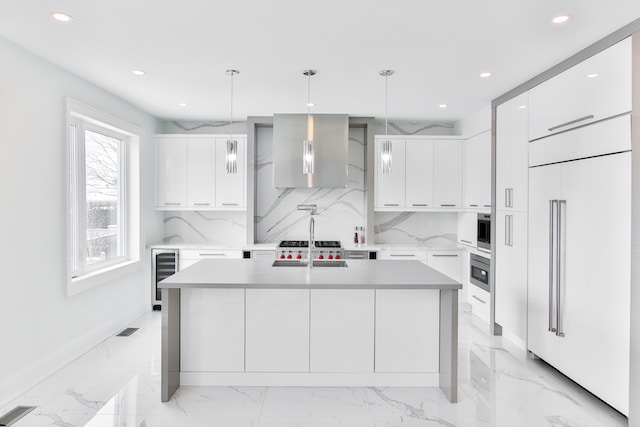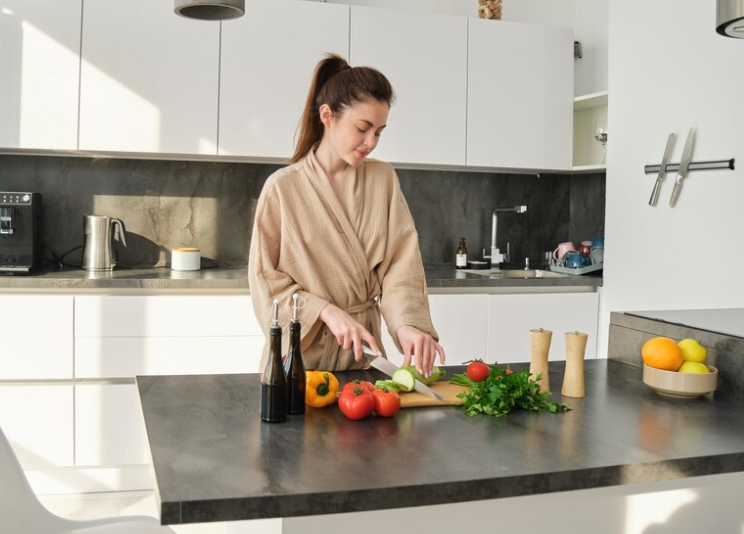How to Find the Best Kitchen Worktops Guide
Selecting the right kitchen worktops is a crucial decision in any kitchen renovation or design project. In this guide, we delve into the various aspects to consider when choosing kitchen worktops that not only enhance the aesthetic appeal of your space but also meet functional requirements. We’ll explore the diverse range of materials available, from classic granite to modern composites, and discuss factors like durability, maintenance, and cost. Whether you’re updating your current kitchen or designing a new one, our guide aims to provide you with all the necessary information to make an informed choice about kitchen worktops, tailored to your personal style and practical needs.
A Guide to Finding the Perfect Kitchen Worktop

When selecting kitchen worktop materials, it is crucial that they satisfy both aesthetic and practical considerations. From laminates to more luxurious stone options, there is an array of worktop choices out there that could meet these objectives.
Granite is ideal for home kitchen use because it withstands heat and can be easily cleaned with soapy water. Other coating surfaces, like marble and concrete, however, are more vulnerable to scratches, thus needing special care in their maintenance.
This table provides a comprehensive overview of the key factors to consider when selecting kitchen worktops, offering practical advice to guide readers through making the best choice for their specific needs and preferences.
| Factor | Consideration | Description | Advice |
|---|---|---|---|
| Material | Durability, aesthetics, and maintenance | Different materials offer various benefits and drawbacks. Options include granite, quartz, laminate, wood, and stainless steel. | Match the material to your usage, style, and maintenance preference. |
| Budget | Cost Effectiveness | Worktop prices vary widely. More expensive materials often offer greater durability and style. | Balance cost with quality and long-term value. |
| Lifestyle Compatibility | Suitability for Cooking Habits | Some materials are more resistant to heat, stains, and scratches, making them ideal for heavy use. | Consider how often you cook and what you cook. |
| Aesthetic Appeal | Style and colour | Worktops significantly contribute to your kitchen’s overall look. | Choose a style that complements your kitchen’s theme. |
| Maintenance Requirements | Ease of upkeep | Certain materials require more maintenance than others. | Decide how much time and effort you can dedicate to upkeep. |
| Size and layout | Customization and Fit | Worktops should fit your kitchen layout perfectly. Custom cuts may be needed for unique layouts. | Ensure precise measurements for a seamless fit. |
| Environmental Impact | Sustainability | Eco-friendly options include recycled materials or sustainable wood. | Consider environmentally friendly options if they are important to you. |
| Installation | Professional vs. DIY | Some worktops need professional installation, adding to the cost. | Factor in installation costs and logistics. |
| Heat Resistance | Tolerance to High Temperatures | It is important for kitchens where hot pots and pans are frequently used. | Choose materials that can withstand high temperatures. |
| Hygiene and safety | Non-porous and food-safe | Non-porous materials prevent bacterial growth and are easier to clean. | Prioritise hygiene, especially if you cook frequently. |
| Trend and Resale Value | Future-proofing and investment | Some materials and styles have a better long-term appeal and can add value to your home. | Consider if the trend will last and add value to your home. |
Tips on Finding the Right Kitchen Worktops for Your House
Selecting the perfect kitchen worktop requires balancing aesthetics, functionality, and budget. Here are some key tips to help you find the right worktop for your kitchen:
- Assess Your Lifestyle: Consider how you use your kitchen. If you cook frequently, prioritise durability and heat resistance. Materials like granite or quartz are ideal for heavy use.
- Match the Style of Your Kitchen: The worktop should complement your kitchen’s overall design. For modern kitchens, consider sleek materials like polished concrete or stainless steel. Traditional kitchens may benefit from classic choices like wood or marble.
- Consider Maintenance Requirements: Some materials require more upkeep than others. Granite and quartz are low-maintenance, while materials like wood and marble need regular sealing and special care.
- Think About Longevity: Invest in a worktop that not only looks good now but will also stand the test of time, both in style and durability. Neutral colours and classic materials typically have lasting appeal.
- Budget Accordingly: Worktops can vary significantly in price. Set a realistic budget but be prepared to invest in quality. Sometimes, spending a bit more upfront can save money in the long run due to its better durability.
- Colour and texture: Choose colours and textures that align with your kitchen’s palette. Lighter colours can make a space feel larger, while dark or bold colours make a statement.
- Environmental Considerations: If sustainability is important to you, look for eco-friendly materials like recycled glass or bamboo.
- Sample the materials: Before making a final decision, view samples in your kitchen environment. Check how the worktop material looks under your kitchen’s lighting and against cabinetry.
- Professional Advice: Don’t hesitate to consult with a kitchen designer or a worktop specialist. Their expertise can guide you towards the best choice for your specific needs and layout.
- Installation and Aftercare: Consider the installation process and aftercare services. Some materials might require professional installation, increasing the overall cost.
Solid wood
Solid wood worktops add an inviting and natural aesthetic to any kitchen, as well as being easy to care for. Oil them regularly to keep them looking their best. However, wooden surfaces aren’t indestructible and may need regular oiling in order to look their best and remain hygienic; however, chopping food on them may expose bacteria hiding within cuts made. In recent years, stainless steel worktops have become an increasingly popular option in domestic kitchens. These heat-resistant, non-porous worktops have an excellent industrial look while remaining easy to sanitise and clean compared to wood surfaces.
Oak is one of the most versatile wood worktop finishes, suitable for both modern and traditional kitchens. Solid oak, made of hard-wearing timber, can last for generations with proper care. Stain or paint it to match your chosen colour scheme, and over time, its aged appearance will only become more beautiful!
Rustic or character-grade solid wood worktops are more cost-effective yet still feature knots, colour variation, and higher sap content than their premium or select counterparts. But this doesn’t disprove their use in home kitchens—they still create stunning aesthetics!
Corian is another versatile, man-made material suitable for many kitchen styles and designs. Extremely durable and heat-resistant, Corian comes in various colours so you can find one to complement the theme or design of your kitchen space perfectly. Furthermore, Corian can be formed into seamless worktops without joins, effectively reducing germ buildup.
Quartz countertops can be more costly, but they are long-term investments if properly maintained. As its non-porous surface is easy to sanitise and maintain hygiene levels, sealing and polishing it helps preserve its shine as well. To maintain its beauty, it is recommended to protect quartz with heat-resistant mats or splashbacks, even though it can withstand temperatures as high as 1,000 F without cracking or shattering under pressure from hot pans or dropped crockery items.
Marble
Marble adds luxury and elegance to your kitchen, making it the ideal natural product to choose. Available in an array of different colours, this premium material stands the test of time with beautiful looks even after extensive use. Despite its expense, marble is worth the investment due to its food-safe and heatproof properties, as well as its stain resistance. However, regular sealing may be necessary to prevent marks.
Granite is another highly sought-after kitchen choice and it comes in various colours and finishes to fit into any design aesthetic. Though more costly, granite will last years with proper care as it resists heat and wear, making it suitable if your cooking habits or those of children depend on heat sources for daily activities. Regular professional sealing and cleaning must take place to avoid scratches or marks appearing over time.
Quartz is an increasingly popular man-made alternative and has proven itself hard-wearing with excellent stain resistance. Available in an array of styles and colours to complement any kitchen design, quartz can even be made to appear like marble with seamless joins! Additionally, heatproof quartz makes an excellent option for anyone who cooks frequently, as it provides greater hygienic advantages over other materials.
Corian, composed of a non-porous polymer-mineral composite material that’s heatproof and stain-proof, offers an economical alternative to quartz with all the same benefits; however, its soft surface may make it vulnerable to scratches over time. Plus, corian is a renewable resource, which contributes to environmental sustainability!
Wooden worktops add a classic yet modern vibe to any kitchen design and have become increasingly popular over time. In addition to being warm and soft to touch, wooden worktops are gentler on china compared to harder surfaces and create a more pleasant acoustic environment in the room. Furthermore, selecting quality timber that has been properly treated and sealed will ensure its long-lasting integrity. It is crucial when selecting cheap or untreated products, as these will quickly decay in a matter of weeks or months.
Soapstone
Soapstone countertops make an eye-catching statement in kitchens with personality. Their soft texture and warm tone pair nicely with rustic, country, modern farmhouse, or minimalist kitchen designs; their patina develops over time to offer a unique aesthetic to complement the rest of your home’s design scheme. Furthermore, unlike many popular stone counter options that require regular oiling maintenance, soapstone is heat resistant, with virtually no additional care required beyond regular oiling sessions.
Choose countertops based on their colour, finish, and edge detail that meet your personal aesthetic needs. Dark hues tend to go well with darker cabinetry, while lighter countertops complement lighter cabinets and flooring. Mix-and-match designs may include choosing different hues for each area of a room. Various edge options exist: smooth, honed finishes provide classic appeal, while hand-chiselled or mitered styles offer ruggedness.
Thickness can have a dramatic impact on how a soapstone slab appears in your kitchen, from substantial and grandiose pieces that boast grandiose qualities to sleek and contemporary ones that feature more contemporary elements. You also have several finishes available to you, such as honed, which highlights natural beauty while protecting from scratches or chips, or flamed finishes, which add depth and dimension while covering imperfections.
As soapstone is naturally antimicrobial, it will not require chemical sealers like other countertop materials do. Furthermore, mining soapstone from the earth eliminates the need for harmful chemicals during the production and disposal of your stone countertop.
If you’re thinking of purchasing a soapstone counter, be sure to discuss its pros and cons with your fabricator first. Ask about their pricing and installation services, as these may vary; additionally, get recommendations from family, friends, and neighbours who recently had their countertops installed; they can provide invaluable advice that could lead you to your ideal countertop solution for your kitchen.
Laminate
Homeowners need to think carefully when choosing their kitchen worktops. Homeowners need to consider how they will use the surface on a daily basis. Those who prepare food from scratch or regularly put hot pans on it need hard-wearing and heat-resistant material that’s easy to keep clean as well as resistant to scratches and stains. A darker surface could help hide watermarks or spills, or opt for smoother material, which makes wiping down easier.
Budget-minded consumers will appreciate the cost-effective laminate worktops that are readily available in many colours and patterns that mimic stone materials. Furthermore, their durability makes them suitable for DIY installation; they can be easily wiped clean, simplifying maintenance; and cutting can even be accomplished using woodworking tools! Unfortunately, they are not resistant to heat, scratches, or water ingress, so it is recommended to use a chopping board or hot pan trivets as preventive measures against water ingress damage.
Stainless steel worktops offer sleek and modern worktops while being easy to keep hygienic and maintain. Not only is stainless steel durable and stain-resistant, but it is also non-porous, allowing for simple wiping down. Unfortunately, stainless steel can be expensive because waterjets are required to cut its surface for proper fitting.
Other options for flooring may include natural timbers that create an aged, rustic appearance; painted surfaces provide more modern designs; however, wood requires extensive care in order to prevent swelling, rotting, and mould growth; it must also be oiled every six months to preserve its quality.
Kitchen worktops are an essential investment in any home and will likely be among the most-used surfaces throughout. Therefore, selecting one that not only complements homeowner taste and decor but will also serve its purpose well and last for many years is of utmost importance. To assist with this decision-making process, this guide looks at various worktop materials available on the market and describes their price, durability, and sustainability qualities.


